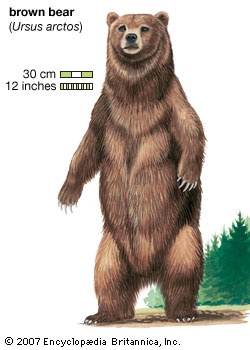brown bear
mammal
 shaggy-haired bear (family Ursidae) native to Europe, Asia, and northwestern North America. More than 80 forms of brown bear have been described; they are treated as several subspecies of Ursus arctos. North American brown bears are traditionally called grizzlies (see grizzly bear).
shaggy-haired bear (family Ursidae) native to Europe, Asia, and northwestern North America. More than 80 forms of brown bear have been described; they are treated as several subspecies of Ursus arctos. North American brown bears are traditionally called grizzlies (see grizzly bear).Eurasian brown bears are generally solitary animals that are able to run and swim well. They are usually 120–210 cm (48–84 inches) long and weigh 135–250 kg (300–550 pounds); the exceptionally large Siberian brown bear (Ursus arctos beringianus), weighing as much as 360 kg (800 pounds), approximates the size of the North American grizzly. Eurasian brown bears feed on mammals, fish, and plant material. Coat colour is highly variable, ranging from grayish white through bluish and brownish shades to almost black. Eurasian brown bears are commonly seen in zoos; formerly they were often trained to move rhythmically to music—the so-called dancing bears of European carnivals and festivals. They originally roamed most of Europe and Asia, and, though perhaps 100,000 remain in northern Eurasia, the southern range has been significantly reduced.
Brown bears are omnivorous and feed on berries, plant roots and shoots, small mammals, fish, calves of many hoofed animals, and carrion. They often cache food in shallow holes, and they dig readily and strongly in search of rodents. Except in some southern areas, bears retire to dens in winter and therefore accumulate large amounts of fat during late summer and autumn. Cubs, usually twins, are born in winter after about 6–8 months of gestation. At birth a cub weighs less than a kilogram.
- rotary engine
- Rotary International
- rotary press
- rotational stress
- Rotblat, Sir Joseph
- Rothaar Hills
- Rothenburg ob der Tauber
- Rother
- Rotherham
- Rotherham, Alan
- Rothe, Richard
- Rothermere, Harold Sidney Harmsworth, 1st Viscount, Baron Rothermere Of Hemsted
- Rothesay
- Roth, Henry
- Roth, Joseph
- Roth, Klaus Friedrich
- Rothko, Mark
- Roth, Philip
- Rothschild family
- Rothschild, Lionel Walter Rothschild, 2nd Baron
- Rothstein, Arnold
- rotifer
- Roti Island
- Rotimi, Ola
- rotogravure printing